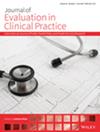Improving Clarity and Interpretability of Items in a Bilingual Index of Propensity to Integrate Research Evidence Into Clinical Decision-Making in Rehabilitation
Abstract
Rationale
Clear, interpretable measures that account for linguistic differences are critical to accurately assess rehabilitation clinicians' propensity to integrate research evidence into clinical decision-making.
Aims and Objectives
To contribute evidence for the clarity and interpretability of a new five-item bilingual multidimensional index of a rehabilitation clinician's propensity to integrate research evidence into clinical decision-making.
Methods
This study was conducted in three sequential steps: (1) We conducted a focus group with occupational therapists, physical therapists, and researchers to review the items and response options for clarity, consistency, and interval properties and agree on equivalency in English and French. (2) We conducted cognitive interviews whereby clinicians elaborated on their interpretation of the item, comprehensibility of items, and appropriateness of response options. Accepted modifications were integrated and tested with subsequent participants. (3) We conducted an online survey to validate the English and French equivalency of response options on a 0–100 scale.
Results
During the qualitative revision process (one focus group with seven participants followed by 27 interviews), the index was revised 12 times with substantial modifications to the use of research evidence and attitudes items.
Conclusion
This study increases the clinical relevance and reduces measurement error of this brief index which can inform on individual or organizational factors influencing a clinician's propensity of integrating research evidence into decision-making and ultimately improve rehabilitation outcomes.


 求助内容:
求助内容: 应助结果提醒方式:
应助结果提醒方式:


